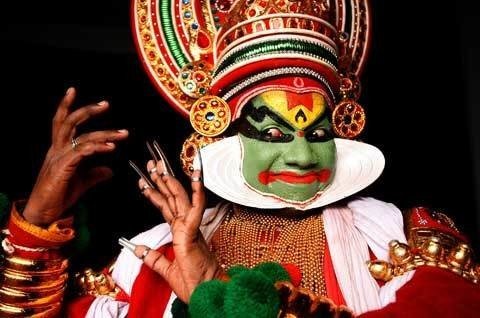
【翻訳編】英語で読むデザイン5 目が踊り、顔が話す?インドのダンス『Kathakali 』
Kathakali is a form of classical dance from Kerala, India.
カタカリは、インドのケララ州のクラシックなダンスです。
It is a genre of performing arts where stories are told through a dance drama especially facial gestures.
顔のジェスチャーを通して物語が語られる舞台芸術に属します。
So enigmatic is this performance that tourists from all over the world flock to Kerala to watch this opera.
世界中からの観光客がこの舞台芸術を見るために、ケララに集まるこのパフォーマンスはとても謎めいた魅力があるのです。
※多少意訳的です。


The dance form incorporates both traditional and modern themes. The traditional themes revolve around folk tales, mythological stories, religious legends, and ancient stories. The contemporary themes have Shakespeare and modern stories.
ダンス形式には、伝統的なテーマと現代的なテーマの両方が組み込まれています。伝統的なテーマは、民話、神話、宗教的伝説、古代物語を中心に展開しています。現代のテーマにはシェイクスピアと現代の物語があります。
The dance was always performed by men but in modern compositions women are involved as well. The roots of the dance can be traced to 500 BCE. In the earlier days the performances were very long, performed for nights together, with brief interludes for the viewer and the artists.
ダンスは常に男性が演じましたが、現代の作曲では女性も参加しています。ダンスのルーツは紀元前500年まで遡ることができます。初期の公演は非常に長く、夜間一緒に行われ、鑑賞者とアーティストのための短い間奏がありました。
The modern performances are shorter. The most striking part of the dance performance is the elaborate makeup and the eye expressions. The make-up has a particular style and an identity.
現代のパフォーマンスはかつてより短くなり、ダンスパフォーマンスの最も印象的な部分は、精巧なメイクと目の表現となりました。メイクアップには特定のスタイルとアイデンティティがあります。

Seven basic types of make-ups are used and the colours are made predominantly from rice paste and vegetable colours. The make-up indicates the characters and has a code. Red is a code for someone with an evil streak, green for a hero, black for forest dwellers, yellow is for monks and so on. The garments too have a code for communication.
7つの基本的化粧の型があり、使用する顔料は主にお米のペーストと野菜の色から作られます。メイクはキャラクターを示します。赤は邪悪な傾向を、緑はヒーローを、黒は森の住人、黄色は僧侶などをあらわすのです。また、衣服にもそうしたキ暗示が取り入れられています。


A Kathakali performance takes a lot of practice and some artists are known to practice for years before they perform on stage. The actors speak in a sign language where, the dialogue is communicated through hand gestures and emotions are expressed through eyes. There are nine facial expressions, that an artist masters, through facial control, in order to express emotions in a play.
カタカリのパフォーマンスには多くの練習が必要であり、俳優達はステージに立つ前に何年も下積みをすることで知られています。俳優達はサインでコミュニケーションをします。会話は手のジェスチャーで、感情は目で表現されます。劇中の感情を表現するために、俳優達が9つの表情(感情)のコントロールを習得します。
Music is what connects the pieces of a performance together. Music is also used to express the mood of the play. Many musical instruments are used in kathakali which shows similarities to Kabuki, the Japanese art form.
A performance that pieces together dance, drama, music and emotions, Kathakali is one dance form that one must watch, when in India.
音楽はパフォーマンスのパートをつなぎ、演劇の雰囲気を表現するために使用されます。カタカリには多くの楽器が使用されており、日本の芸術様式である歌舞伎と類似しています。
ダンス、ドラマ、音楽、そして感情をつなぎ合わせたパフォーマンスであるカタカリは、インドに来た際には、必見の1つの芸術です。
後記と注目の単語など
なんとなく薄々思っていたのですが、歌舞伎と似ているなと感じていましたが、末尾に歌舞伎について触れられていましたね。
日本人なので、歌舞伎に慣れてしまっていますが、カタカリを始めた見た人も、歌舞伎を初めて見た人も、そのパワフルな表情とメイクに、同じ様な衝撃を受けるのかもしれません。
不思議なものですね。
また、赤が悪人を表すのは理解しやすいですが、黒が森の住人、緑がヒーロー、、、。
色は文化によって意味が変わるので、なかなか興味深い話でありました。
■単語・表現
(※わからない場合は翻訳と見合わせるか、ググってみてください)
・religious
日本ではあまりなくても海外では頻出。アート領域では特に。
・mythological
同上
・elaborate
デザインに使われがちですが、ほかでも割とよく出てきます。
・similarities
これもよく英文には出てきますし、使いますね。
では、今回はここまで:)
